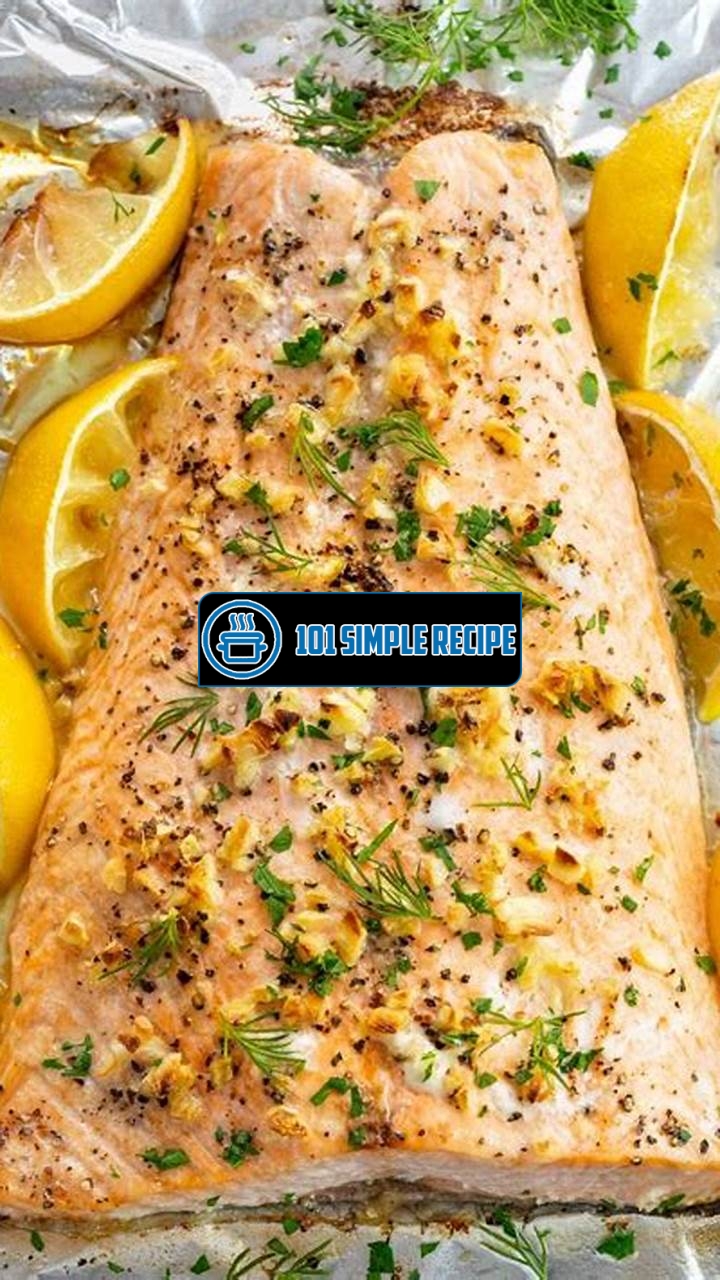Are you a seafood lover? If yes, then mastering the art of baking salmon to perfection is a skill you must acquire. Baking salmon not only enhances its flavor but also preserves its nutritional value. Whether you are a seasoned chef or a cooking enthusiast, this article will guide you through the process of baking salmon like a pro. ️ From choosing the freshest salmon fillet to marinating it in delectable flavors, we’ve got you covered. So, put on your apron, grab your baking tray, and let’s dive into the secrets of creating a mouthwatering salmon dish that will leave you and your guests craving for more.

Understanding the Importance of the Right Temperature
When it comes to baking salmon, the temperature you choose plays a pivotal role in achieving the perfect dish. Understanding the importance of the right temperature and how it can affect the final results is key to mastering the art of baking salmon to perfection.
Why Temperature Matters
The temperature at which you bake salmon is critical because it determines the overall texture, moisture, and flavor of the fish. Salmon is a delicate and oily fish that requires precise cooking to enhance its natural flavors and maintain its moistness.
When cooked at the wrong temperature, salmon can easily become dry and tough. On the other hand, if it is undercooked, you risk consuming raw or potentially harmful bacteria.
The Ideal Temperature Range
The ideal temperature range for baking salmon is between 375°F (190°C) and 425°F (218°C). Within this range, you have the flexibility to adjust the cooking time based on the size and thickness of the salmon fillet.
By baking at a slightly higher temperature, around 400°F (204°C), you can achieve a nice crust while still maintaining a tender and juicy interior. This higher temperature helps to seal in the moisture and develop a flavorful outer layer.
Factors That Impact Temperature
Various factors can impact the baking temperature for salmon.
1. Thickness of the Salmon Fillet: Thicker fillets require a slightly lower temperature and longer cooking time to ensure even and thorough cooking.
2. Type of Oven: Different ovens may have variations in temperature accuracy. It is always a good idea to use an oven thermometer to ensure the desired temperature is reached.
3. Preferred Doneness: The level of doneness you prefer also affects the baking temperature. If you enjoy a medium-rare salmon, you may opt for a lower temperature, while those who prefer well-done salmon might choose a slightly higher temperature.
4. Additional Ingredients: If you are baking salmon with additional ingredients such as herbs, citrus, or glazes, the recipe may require adjustments to the baking temperature to ensure the flavors are infused properly.
Overall, understanding the importance of the right temperature when baking salmon is essential for achieving excellent results. By following the ideal temperature range and considering the various factors that impact temperature, you can master the art of baking salmon to perfection.
Choosing the Best Temperature for Baking Salmon
When it comes to baking salmon, achieving the perfect temperature is crucial. The right temperature can greatly impact the taste, texture, and moisture of the salmon. In this article, we will explore different temperature options and their effects on your salmon dish, allowing you to master the art of baking salmon to perfection.
Low and Slow: The Gentle Approach
One option for baking salmon is to use a low and slow method. This involves baking the salmon at a lower temperature for a longer period of time. By using a lower temperature, the salmon cooks more gently, resulting in a tender and moist texture.
This method is particularly great for individuals who enjoy a more delicate flavor. The low temperature allows the flavors to develop slowly, creating a subtle and nuanced taste. The salmon will be less likely to dry out, ensuring a succulent and enjoyable eating experience.
- Temperature: Preheat the oven to 275°F (135°C).
- Benefits:
- Tender and moist texture
- Delicate and nuanced flavor
- Succulent end result
High and Fast: The Quick Blast
On the opposite end of the spectrum, we have the high and fast method. This involves baking the salmon at a higher temperature for a shorter period of time. By using higher heat, the salmon cooks quickly and develops a crispy exterior while maintaining a tender interior.
This method is perfect for those who enjoy a slightly charred and caramelized flavor. The higher temperature promotes browning and caramelization, resulting in a richer and more intense taste. Additionally, this method is great for individuals who are short on time but still want to enjoy a delicious salmon dish.
- Temperature: Preheat the oven to 425°F (220°C).
- Benefits:
- Crispy exterior and tender interior
- Charred and caramelized flavor
- Time-saving option
Medium and Balanced: The Golden Middle Ground
If you’re looking for a balance between the low and slow method and the high and fast method, the medium and balanced approach is the way to go. This involves baking the salmon at a moderate temperature, allowing it to cook evenly and retain its moisture.
The medium temperature ensures that the salmon is cooked to perfection, with a moist and flaky texture. The flavors have just the right amount of time to develop, resulting in a well-rounded and satisfying taste. This method is a safe bet for anyone who wants to achieve a consistently delicious outcome.
- Temperature: Preheat the oven to 375°F (190°C).
- Benefits:
- Moist and flaky texture
- Well-rounded and satisfying flavor
- Consistently delicious results
Overall, the temperature you choose when baking salmon plays a crucial role in determining the taste, texture, and moisture of the final dish. Whether you opt for a low and slow, high and fast, or medium and balanced approach, mastering the art of baking salmon to perfection is within your reach.
Remember, the temperature is just one factor to consider when baking salmon. It’s also important to choose high-quality salmon, season it well, and monitor the cooking time to ensure the best possible outcome.
Happy baking and enjoy your perfectly cooked salmon!
White Castle Recipe is a popular dish that you can try alongside your salmon.
Taking Factors into Consideration
When it comes to baking salmon to perfection, there are several important factors to consider. Understanding these factors will help you determine the ideal temperature to achieve the perfect bake every time. Let’s delve into the details and explore these factors one by one.
The Thickness of the Salmon
The thickness of the salmon plays a crucial role in determining the baking temperature. Thicker cuts of salmon require a lower baking temperature to ensure the center is cooked thoroughly without overcooking the outer layers. On the other hand, thinner cuts of salmon may require a slightly higher baking temperature to achieve the desired level of doneness. Therefore, it is essential to take into account the thickness of the salmon fillet before deciding on the baking temperature. Remember, adjust the temperature based on the thickness of the salmon for perfectly cooked results.
Skin-On or Skinless
Whether your salmon is skin-on or skinless also impacts the ideal baking temperature. If you have a skin-on salmon fillet, it acts as a protective layer, helping to retain moisture and heat. In this case, a slightly higher baking temperature may be suitable to ensure the salmon cooks through while also achieving a crispy, golden skin. On the other hand, if you have a skinless salmon fillet, you may opt for a slightly lower baking temperature to prevent the salmon from drying out. Consider the presence or absence of skin while determining the optimal temperature for baking your salmon. Keep in mind, adjust the baking temperature based on whether your salmon has skin or not, to ensure the best outcome for your dish.
The Oven You’re Using
The type of oven you are using can significantly impact the baking temperature required for salmon. Different ovens have different levels of heat distribution and accuracy, which can affect the cooking process. If you have a conventional oven, you may need to set a slightly higher temperature to compensate for any heat loss or fluctuations. On the other hand, if you have a convection oven, the heat is circulated more evenly, allowing for a lower baking temperature. It is important to understand your oven’s characteristics and make adjustments accordingly to achieve the perfect bake. Note that adjusting the baking temperature based on your oven type will help you achieve consistent results.
By considering these factors – the thickness of the salmon, whether it’s skin-on or skinless, and the type of oven you’re using – you can determine the ideal temperature for baking salmon to perfection. Remember, adapting the temperature based on these factors will help you achieve the best results and impress your guests with a deliciously cooked salmon dish every time. So, take these factors into consideration and enjoy the art of baking salmon to perfection!
Mastering Cooking Times
Discover how the cooking time is influenced by temperature, ensuring your salmon is cooked to perfection.
Understanding Cooking Times at Different Temperatures
When it comes to baking salmon, understanding the cooking times at different temperatures is crucial. The temperature at which you cook the salmon directly affects the cooking time and determines whether your fish will be moist and tender or dry and overcooked.
To achieve the perfect balance, it’s important to know the recommended cooking temperatures for baking salmon. The ideal temperature range for baking salmon is typically between 350°F (175°C) and 425°F (220°C).
At lower temperatures around 350°F (175°C), the salmon takes longer to cook. This slower cooking process allows the fish to retain more moisture, resulting in a soft and flaky texture. It’s a great option if you prefer your salmon to be tender and slightly translucent in the center.
On the other hand, baking salmon at higher temperatures around 425°F (220°C) reduces the cooking time. The higher heat helps to create a deliciously crispy exterior while maintaining a moist and juicy interior. This method is perfect for those who enjoy a slightly caramelized crust with a well-cooked center.
It’s important to note that the temperature and cooking time may vary depending on the thickness of your salmon fillet. Thicker cuts may require a slightly longer cooking time, while thinner fillets will cook faster. Use a meat thermometer to ensure the salmon reaches an internal temperature of 145°F (63°C) for optimal doneness.
Using the Internal Temperature as a Guide
️ The internal temperature of your salmon is a key indicator of its doneness. To accurately measure the internal temperature, insert a meat thermometer into the thickest part of the fillet without touching the bone.
For a perfectly cooked salmon, aim for an internal temperature of 145°F (63°C). This ensures that the fish is cooked through while remaining moist and tender. If the temperature exceeds 145°F (63°C), the salmon may become dry and overcooked.
Keep in mind that the cooking time will vary based on the size and thickness of your salmon fillet. As a general guideline, plan for approximately 10 minutes of cooking time per inch (2.5 cm) of thickness. Adjust the time accordingly to achieve your desired level of doneness.
Letting It Rest: The Final Touch
Once your salmon has reached the desired internal temperature, it’s important to let it rest before serving. Allowing the salmon to rest for a few minutes ensures that the juices redistribute, resulting in a more flavorful and succulent dish.
During the resting period, cover the salmon loosely with aluminum foil to retain its warmth. The internal temperature will continue to rise slightly, so be mindful not to overcook it. After resting for about 5 minutes, your salmon is ready to be enjoyed.
Mastering the art of baking salmon to perfection requires an understanding of cooking times and temperatures. By adjusting the baking temperature and using the internal temperature as a guide, you can ensure that your salmon turns out tender, moist, and flavorful every time. So go ahead and explore different cooking temperatures to find your preferred method of baking salmon to perfection!
Punch Bowl Recipe is a refreshing beverage you can enjoy with your salmon meal.
Impress with Seasonings and Marinades
When it comes to baking salmon, the right seasonings and marinades can elevate your dish from ordinary to extraordinary. By exploring various flavor combinations, you can create a memorable dining experience that will impress your guests. Whether you prefer a citrusy delight, an Asian infusion, or an herbaceous indulgence, there are endless possibilities to enhance the flavor of your baked salmon.
Citrusy Delights: Lemon and Dill Marinade
One classic combination for baked salmon is a citrusy marinade with lemon and dill. The tangy and refreshing flavors of lemon perfectly complement the rich and buttery taste of salmon. To prepare this marinade, combine freshly squeezed lemon juice, minced garlic, chopped dill, olive oil, salt, and pepper. Let the salmon marinate for at least 30 minutes to allow the flavors to penetrate the fish. The acidity of the lemon juice helps tenderize the salmon while infusing it with a bright and zesty taste.
Lemon and dill marinade is a versatile option that pairs well with different types of salmon. Whether you’re using fillets, steaks, or a whole side of salmon, this marinade will enhance the inherent flavors of the fish. The lemon adds a burst of freshness, while the dill provides an aromatic and herbaceous note. This combination is sure to impress your guests and leave them craving more.
Asian Infusion: Soy and Ginger Glaze
If you’re looking to add an Asian twist to your baked salmon, a soy and ginger glaze is the perfect choice. This glaze creates a savory and slightly sweet coating on the salmon, resulting in a delicious flavor profile. To make the glaze, mix together soy sauce, minced ginger, minced garlic, honey, sesame oil, and a splash of rice vinegar.
The soy sauce adds a deep umami flavor, while the ginger provides a subtle spiciness. The honey adds a touch of sweetness that balances out the savory elements of the glaze. When baking the salmon with this glaze, the sugars in the honey caramelize, creating a beautiful golden brown crust on the outside of the fish. This glaze is a crowd-pleaser and will transport your taste buds to the vibrant flavors of Asian cuisine.
Herbaceous Indulgence: Garlic and Herb Butter
If you’re a fan of rich and indulgent flavors, a garlic and herb butter is the way to go. This combination creates a luscious and decadent topping that melts into the salmon as it bakes. To make the garlic and herb butter, mix softened butter with minced garlic, chopped fresh herbs such as parsley and thyme, lemon zest, salt, and pepper.
The butter adds a luxurious creaminess to the salmon, while the garlic infuses it with a bold and pungent taste. The herbs provide a fresh and aromatic element that complements the richness of the butter. As the salmon bakes, the butter melts and coats the fish, resulting in a moist and flavorful dish. This herbaceous indulgence is perfect for those who enjoy a buttery and savory experience.
Experimenting with different seasonings and marinades is the key to mastering the art of baking salmon to perfection. Whether you choose a citrusy marinade, an Asian-inspired glaze, or a garlic and herb butter, each option offers a unique flavor profile that will tantalize your taste buds. So go ahead and explore the world of salmon seasonings, and impress your guests with a perfectly baked salmon dish that they won’t soon forget.
Weight Loss Recipe can be a healthy option to complement your salmon dish.
Thank you for taking the time to read this article on the optimal temperature to bake salmon. We hope that you found the information helpful and insightful. Whether you’re a seasoned chef or just starting out in the kitchen, knowing the right temperature for baking salmon is essential for achieving the perfect dish. Remember, ️ temperature is key! So bookmark this page, and visit us again for more cooking tips and recipes. Happy baking, and enjoy your delicious salmon!
Frequently Asked Questions
Here are some frequently asked questions about baking salmon:
| No. | Questions | Answers |
|---|---|---|
| 1. | What is the best temperature to bake salmon? | The ideal temperature for baking salmon is 375°F (190°C). |
| 2. | How long should I bake salmon for? | The cooking time for salmon depends on the thickness of the fillet. As a general rule, bake salmon for 10-12 minutes per inch of thickness. |
| 3. | Should I cover the salmon with foil while baking? | Yes, covering the salmon with foil helps to trap moisture and keep the fish tender while baking. |
| 4. | Should I season the salmon before baking? | Yes, seasoning the salmon before baking enhances its flavor. You can use herbs, spices, or marinades to add extra taste. |
| 5. | How can I check if the salmon is cooked properly? | The salmon should be opaque and flake easily with a fork when it is cooked through. You can also use a meat thermometer to ensure it reaches an internal temperature of 145°F (63°C). |
| 6. | Can I bake frozen salmon? | Yes, you can bake frozen salmon. Just increase the cooking time by 5-10 minutes to ensure it is thoroughly cooked. |
Closing Thoughts
We hope you found our guide on the optimal temperature to bake salmon helpful. Remember, cooking salmon to perfection requires the right temperature and technique. By following our tips, you’ll be well on your way to creating a delicious and healthy meal. Visit us again for more culinary advice and expert tips. Until then, happy baking!
Jump to Recipe
Baked Salmon Recipe

Learn the ideal temperature to bake salmon for a perfectly cooked and flavorful dish. With our step-by-step instructions, you’ll be able to create a delicious meal every time.
- 4 salmon fillets
- 1 tablespoon olive oil
- Salt and pepper to taste
- Lemon wedges for serving
- Preheat the oven to 375°F (190°C).
- Place the salmon fillets on a baking sheet lined with parchment paper. Drizzle the fillets with olive oil and season with salt and pepper.
- Bake the salmon in the preheated oven for 10-12 minutes per inch of thickness, or until the salmon is opaque and flakes easily with a fork.
- Remove the salmon from the oven and let it rest for a few minutes. Serve warm with lemon wedges and enjoy!






